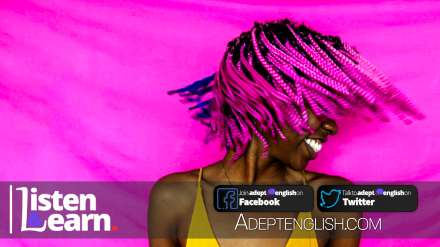English For Conversation
If you are struggling to find something to talk about in English for a conversation, then keep it simple and talk about something that matters to everyone. Today we will talk about hair, which for most people is an important topic. It might be important for religious reasons, for trendy fashion reasons. It might be important because you have little hair or maybe none. I guarantee it will come up in your English conversations at some point so you need to know at least the popular styles so you can talk about it.
Hair is often a big part of our identity it says something about us, before we even start talking. It’s one of those discussion topics that will never go out of fashion, like the British always talking about the weather.
You might have noticed that this podcast is our 300th podcast. With each podcast on average 8 minutes long, that is 40 hours of free high quality English lessons you can listen to right now, each of which comes with a full and free PDF transcript. We put a little of us into everyone of them and hope they help you improve your English speaking.
If you get the chance, please let us know, like Francesco did on our YouTube Channel a few days ago.
Thanks a lot for your podcasts! Listen to your podcasts is a funny and relaxing way to learn english very fastly. I’ve improved a lot all my english skills (comprehension, reading, writing) thanks to these podcasts i got an excellent grade at university. Bye bye😊😊
Francesco, YouTube
Most Unusual Words:
Topknot
Footballers
Samurais
Most common 2 word phrases:
| Phrase | Count |
|---|---|
| your hair | 9 |
| you might | 7 |
| a bun | 7 |
| of hair | 6 |
| piece of | 5 |
Listen To The Audio Lesson Now
The mp3 audio and pdf transcript for this lesson is now part of the Adept English back catalogue . You can still download and listen to this lesson as part of one of our podcast bundles.Transcript: Learn About Your Hairdo And Practice English For Conversations
Hi there and welcome to Adept English. One of our missions, one of our goals here at Adept English, is to give you English for conversation. By this, I mean that we help you get to know not just the obvious vocabulary, the type that you learn on an English language course, but also English for conversation, the words that are in common use, but not necessarily formal or in the dictionary. How can I learn English conversation? Well, start with Adept English podcasts!
Everyday words
Shall we work on some vocabulary today – and the type of vocabulary that you meet in every day life, but you’re unlikely to learn on a college course? That’s the kind of vocabulary we really like to help you with at Adept English! How about a group of words to do with how you tie up your hair? That may not be a phrase you recognise immediately – so let me explain. If you have very short hair, or perhaps no hair at all, then tying up your hair isn’t something you will do. But if your hair is long, then it’s likely that sometimes you might tie it up, to keep it out of your face or your eyes.
It’s the sort of thing which students do when they’re studying, they tie up their hair, so that it’s out of their face. Maybe you do that when you’re studying? Or if you go swimming or to a beach when it’s hot – you might tie up your hair. It’s also what we do with children’s hair, so that it’s tidy when they go to school. People who are sporty often tie up their hair – hair makes you hot when you’re exercising. So you might see footballers with hair tied up in some way – and for ballet dancers – they always have their long hair tied up.
“Some of the worst mistakes in my life were haircuts.”
▪️ Jim Morrison, Singer
So what are the names we give in English to the various ways of tying up your hair? These are words which might come up in normal English conversations with friends.
Plaits and braids
Well, if you think of “Rapunzel, Rapunzel, let down your golden hair” – I think there was a podcast last year, where I told the story of Rapunzel, so that you could practise your understanding on short stories? Well, depending upon the picture, the drawing, the illustration of this story of Rapunzel, sometimes the long piece of hair in this story is shown as a plait. Plait is UK English and it’s spelt P-L-A-I-T. And it’s when you weave together three pieces of hair, three strands of hair to form one piece.
It’s a traditional hairstyle for American Indians. So you might put plaits in your daughter’s hair to keep in tidy for school – one at each side. In US English, this method of weaving hair and tying it – well, instead of plaits they’re called braids, B-R-A-I-D-S. If you’re not sure what I mean by plaits or braids, put it into your search engine on images and have a look! So if you’ve got long hair, there are all sorts of ways that you can wear plaits.
Video
Bunches
Still on the subject of how a child might have their hair tied for school, you might opt for bunches. Normally it would be little girls who wore their hair in bunches – but there’s no rule against older people or boys wearing bunches, if they want to – you just don’t see it often! The word ‘bunch’ in English, B-U-N-C-H can be used of all kinds of things. I used it in a podcast recently when talking about ‘bunches of grapes’. So ‘bunch’ can be used about grapes and very commonly, it’s used of flowers.
You might give someone a bunch of flowers as a gift. But here we are talking about hair on your head. So as a hairstyle, ‘bunches’ is when you’ve made a parting in the middle of your head – and you bunch the hair together – one bunch at each side, held by elastic or some kind of band or hair tie. Bunches can be over your ears or at the back of your head. They can be high or low! And there are usually two of them, one each side.
Buns and Manbuns
If you’re talking about the sort of hair style a ballet dancer might have, or a ballerina, then that’s called a bun, B-U-N. So a bun is a noun – and it usually means a cake, a little round cake, that’s just enough for one person to eat. That’s a bun. So of course, if you gather your hair together into a bun shape and fix it, probably with hair pins – then this is known as a bun, after the cake. And a hair pin, P-I-N, is a little piece of metal bent into two, which is useful for pinning your hair into position.
So that is a bun. And now much more common is the male version of the bun, commonly known as a ‘man bun’, two words, man M-A-N, bun B-U-N! Again go to Google or whatever search engine you use, if you’re unsure. If you put in ‘man bun’ - you’ll get pictures! Very popular with footballers, the man bun! You don’t often find it on the older man – it is the province of the young, I think! And the man bun is often worn with a full beard, that’s the hair on the chin – I suppose just to make sure that there isn’t confusion, or any androgyny in the appearance. Androgyny – there’s a good word – that’s a noun – and it means when someone looks neither male nor female, it’s unclear. Gareth Bale is a footballer from the UK, known for his man bun.
Just pausing a minute there to tell you about our courses. If you haven’t already bought Course One: Activate your Listening , then this is a course which builds up your level of English, your vocabulary in a more structured way than the podcasts. It also introduces you to English conversation dialogues – so you get to hear other voices, as well as mine, other people as well as me. So that’s real English conversations to improve listening and speaking. And if you’d like 10% discount on Activate your Listening – then sign up for our Seven Rules of Adept English Course first. That’s a hot tip.
Boost Your Learning With Adept English
The ponytail
So back to our English conversation topic ‘how you tie up your hair’. The next one is also something that your little daughter might wear to school – but also might be worn by a big hairy man on a motorbike – and the word here is a ‘ponytail’. So a ponytail, P-O-N-Y-T-A-I-L is rather like a bunch – but instead of two, there is just one piece of hair, gathered into a tie or a hair band at the back of the head.
The origin of the word ‘ponytail’ isn’t difficult to work out – certainly not for me on a Sunday morning, when I’m on a horse, walking behind another horse. A ponytail is so-called because it looks like a pony’s tail. A pony, P-O-N-Y, is a small horse and a tail, of course, is what they have at the back! What is also noticeable – ponytails are very popular amongst the people who ride horses – not sure why, but it’s true! Perhaps it just keeps the hair out of the way.
📷
A photograph of girls with hair braids used in talking about hair styles in English conversation.
The topknot
And another piece of hairy vocabulary for today – the topknot. So this one is spelt T-O-P-K-N-O-T. It think this one could be spelt with a space as two words, or it’s beginning to be used as all one word. Confusing perhaps to pronounce it if you just see it written as one word – when there ‘s a P-K-N in the middle, but much easier to say if you think of it as two separate words top knot – and of course, there’s a silent K there. So what is a topknot? Well, it’s rather like a bun, but it is much more on the top of your head. I recall my elder daughter, when she was studying, would often have her hair in a top knot. She still has quite long hair – and a top knot, sometimes in hot weather. It just gets all the hair out of the way.
The topknot is also significant as it’s worn by Sikhs – it’s part of the Sikh religion. In English, Sikhism, S-I-K-H-I-S-M is the name of the religion and people who practise this religion are known as Sikhs, S-I-K-H-S. And many Sikhs keep the practice of not cutting their hair and instead wear it in a topknot style which is known as a Joora, J-O-O-R-A. For men, a turban may be worn over the top. But you certainly see Sikh children in the UK, with their Joora.
Topknots have also been worn through history by Japanese Samurais – there’s a word for this, which is spelt C-H-O-N-M-A-G-E. But I couldn’t find how to pronounce this – Chon-maje? My internet research let me down on this – so many different pronunciations – I don’t know which is the right one! So if you do know how to pronounce this word C-H-O-N-M-A-G-E. for a Japanese topknot correctly – please let us know! There’s a challenge for you!
Half up half down
Shall we do one more hair tying style today? This one I didn’t know – my younger daughter told me this. It’s certainly a hair style I’ve worn myself in the past, but I didn’t know until writing this podcast that it has a name. And that is a ‘half up half down’. So it’s the hairstyle, usually worn by women, where you take a small piece of hair from each side, above your ear and you tie it up at the back. It makes sense as a name – if you do this, your hair is ‘half up half down’.
Download The Podcast Audio & Transcript
Think of Legolas in Lord of the Rings – the lovely Orlando Bloom with a half up half down hairstyle. And again, if you put ‘half up half down’ into your search engine, you’ll find pictures! There you are – I’m still learning English words and expressions all the time too!
Goodbye
So there you are, some English for conversation, especially conversations you might have or hear about hair! And conversations which you wouldn’t understand without this vocabulary. It’s really good to learn everyday English. Anyway, enough for now. Have a lovely day. Speak to you again soon. Goodbye.








